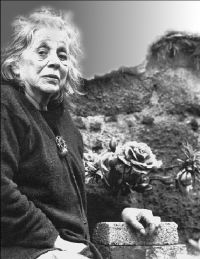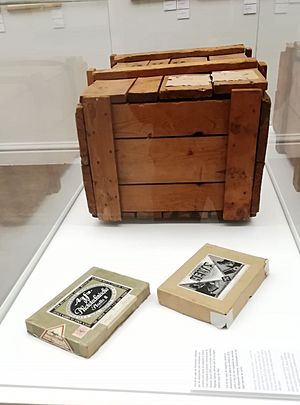Kati Horna facts for kids
Quick facts for kids
Kati Horna
|
|
|---|---|
 |
|
| Born |
Katalin Deutsch
May 19, 1912 Szilasbalhás, Magyar Királyság (Mezőszilas, Austria-Hungary)
|
| Died | October 19, 2000 (aged 88) |
| Nationality | Mexican |
|
Notable work
|
Umbral, Nosotros |
| Style | photojournalism, Surrealist |
| Spouse(s) | José Horna |
Kati Horna (born Katalin Deutsch, May 19, 1912 – October 19, 2000) was a famous photographer. She was born in Hungary, which was then part of the Austro-Hungarian Empire. Kati lived in France, Germany, and Spain before becoming a Mexican citizen.
She was a photojournalist, meaning she took pictures for news stories. She was also a surrealist photographer, creating dream-like and unusual images. Many of her early photos were lost during the Spanish Civil War. Kati Horna was one of the most important women photographers of her time. She changed how people saw war through her pictures. She used a method called "gendered witnessing." This meant she showed war from a woman's point of view. She focused on how war affected women and children, not just the soldiers fighting. One of her most famous pictures is Tête de poupée (doll's head).
Contents
About Kati Horna
Her Early Life
Kati Horna was born in 1912 into a well-off Jewish family. This was a time of big changes and problems in the Austro-Hungarian Empire. Budapest, where Kati grew up, faced many money problems after World War I.
Her father was a banker. After he died, photography became a way for Kati to earn a living. It also helped her share her political ideas. The dangers and unfairness around her deeply shaped her beliefs.
As a teenager, Kati lived in Berlin, Germany. There, she met famous people like Bertolt Brecht. She was also inspired by art movements like Bauhaus, Surrealism, and Constructivism. She especially liked Lajos Kassak's idea that photography could help change society. Another person who influenced her was Karl Korsch. He taught her about radical politics. This made her love for storytelling through photos even stronger.
When she was 20, Kati became a student of photographer József Pecsi. At this well-known school in Budapest, she learned basic photography skills. She also met Robert Capa there. They stayed friends until Capa's death in 1954. Capa took pictures of battles, like in the Spanish Civil War. Kati, however, took pictures of people affected by war. She showed the strength of women during difficult times. Capa liked to be on the front lines, taking action shots. Kati and Capa shared similar political views. They even took portraits of each other.
In 1933, Kati followed Capa to Paris, France. There, she photographed everyday life in the streets and cafes. Her photos for the French Agence Photo (1934) showed her sharp eye for humor. Her series Flea Markets (1933) and Reportage dans les Cafés de Paris (1934) are from this time. Besides real-life scenes, she also tried more experimental, surrealist work. Even though she became popular, Kati preferred to work for smaller magazines like Umbral.
The Spanish Civil War
In 1937, Kati moved to Barcelona, Spain, during the Spanish Civil War. The Spanish government asked her to photograph the war. She also documented daily life in towns near the front lines. These towns included Aragón, Valencia, Madrid, and Lérida. She photographed older women, young children, babies, and mothers. Her choice of subjects was seen as very forward-thinking.
Kati's photos were published in newspapers and magazines that supported the anarchist movement. They showed the harsh effects of war on regular people. This was a new way to see war, as it was the first big European conflict not just fought by soldiers. Kati was an editor for Umbral magazine. There, she met José Horna, a sculptor, who later became her husband. Some of her photos were used as posters to support the Republican side. She also worked with other magazines that shared anarchist ideas. These included Tiempos Nuevos and Mujeres Libres. Her pictures from the civil war showed her support for the Republicans. They also made her very well-known.
Life in France
In 1939, Kati and José Horna escaped to Paris. They had to leave Spain because of the Spanish Fascist authorities. Kati was shocked by how much poverty she saw in Paris. Her career then took a new direction. She became a reporter for Lutetia-Press. She also met her friend Robert Capa again. He inspired her to create poetic photo stories and staged pictures. He also influenced her to use masks and dolls in her work.
During World War II, when the Nazis occupied France, Kati and José got married. They later found safety in Mexico. There, they met other artists who were also escaping the war in Europe. These friends included Remedios Varo and Leonora Carrington. Kati Horna and this group became very close. Their friendship was even shown in a 2010 art show called Surreal Friends. One of Kati Horna's most famous photos shows Remedios Varo wearing a mask.
Life in Mexico
Kati Horna arrived in Mexico in October 1939, when she was 27. Mexico became like a "motherland" to her. She said she felt patriotic only for Mexico. She lived there for the rest of her life. She contributed to many magazines like Todo (1939) and Mapa (1940).
In 1944, Nosotros magazine hired her as a full-time photographer. She published photo series like Puppets in the Penitentiary. She also took portraits of famous people like Alfonso Reyes in his library. In 1958, Kati Horna became the main photo editor for Mujeres magazine. In the second half of the 20th century, she also did work for many other magazines. She also worked on more experimental projects that had a surrealist touch.
Kati Horna was also very interested in architecture. She worked with architects like Luis Barragán. She photographed old buildings to record their condition. She also took pictures of new public buildings. These included the National Museum of Anthropology and the University Campus. In 1967, she photographed the pre-Olympic games. Kati also liked to photograph old and falling-apart buildings. This part of her work connected to her surrealist style. These photos could be understood in many different ways.
From 1958 to 1963, she taught photography. She taught at the National School of Plastic Arts and the Universidad Iberoamericana. Some of her most famous works include What Goes in the Basket (1939) and La Castañeda (1945).
Kati Horna passed away in October 2000. Her work has been shown in many art exhibitions. These exhibitions have been held in Mexico, Spain, and other countries.
Her Legacy
During the Spanish Civil War, Kati Horna used her Rolleiflex camera. She took pictures in Barcelona and other parts of Catalonia. These photos were for the public relations office of the CNT-FAI. This was an anarchist movement in Spain. The photos were used to boost morale and encourage action against the Spanish Fascist movement.
When the civil war ended, her photos were sent in wooden crates to the International Institute of Social History in Amsterdam. For 80 years, her photos and those of another photographer, Margaret Michaelis, were forgotten. Spanish art historian Almudena Rubio rediscovered them. Most of these pictures had never been seen before. They were shown for the first time in an exhibition in Madrid in June 2022.
Horna's rediscovered photos show scenes of life in a prison. They also show people getting free haircuts at a shared barbershop. One photo shows a former church turned into a carpentry workshop. Others show trenches on the front lines in Aragón. Almudena Rubio said about the exhibition:
"The work of Michaelis and Horna is special. It shows us the revolutionary experience behind the front lines. This part of history was often ignored. It was started by the anarchists of the CNT-FAI. Also, it helps us learn more about the lives of these two photographers during the civil war. It helps us better appreciate their work in anti-fascist Spain."
Exhibitions
- 1992: Kati Horna. Photographs of the Spanish Civil War (1937-1938), University of Salamanca (Spain)
- October 29 - November 21, 2009: Portraits of the Conflict, Palacio de la Merced, Córdoba (Spain)
- June 19 - September 12, 2010: Surreal Friends: Leonora Carrington, Remedios Varo and Kati Horna, Pallant House Gallery, Chichester (United Kingdom)
- September 14 - November 26, 2012: Nostalgia for the Lost / Amazement for the Found, Museo de Arte Contemporáneo de Oaxaca - MACO (Mexico)
- December 7, 2013 - April 28, 2014: Kati Horna, Museo Amparo, Puebla (Mexico). This exhibition also traveled to the Musée du Jeu de Paume, Paris (June 3 - September 21, 2014) and the Museo de Arte Contemporáneo de Monterrey - MARCO (January 30 - May 24, 2015).
- September 14 - December 17, 2016: Told and Untold: The Photo Stories of Kati Horna in the Illustrated Press, Americas Society, New York (USA)
See also
 In Spanish: Kati Horna para niños
In Spanish: Kati Horna para niños


